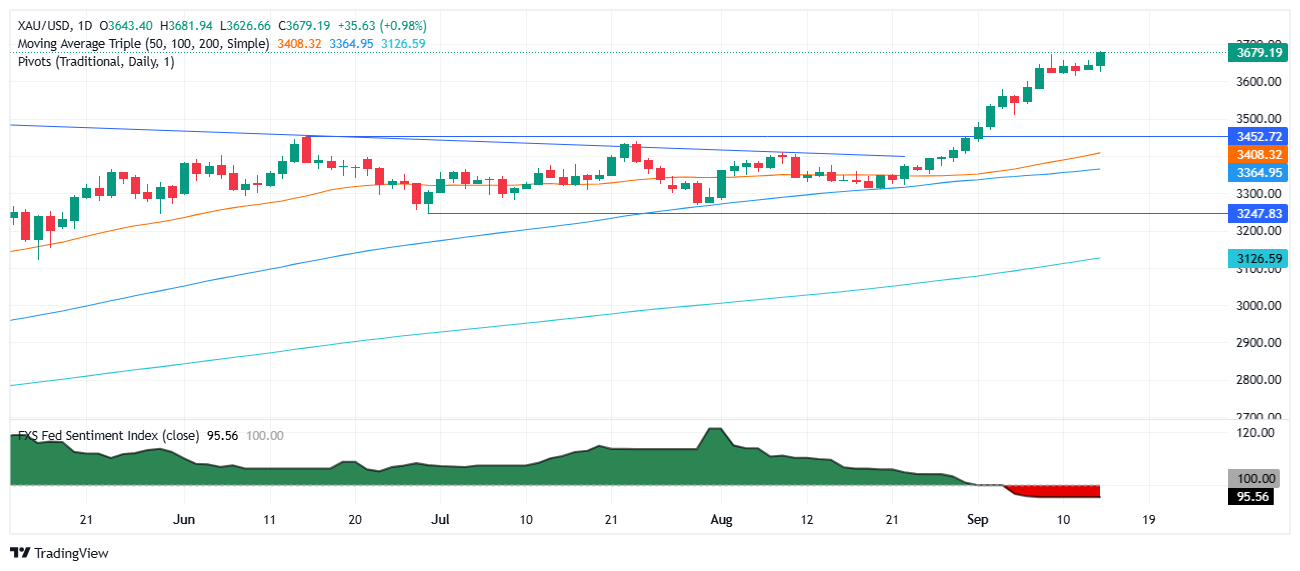Breaking: Gold hits $3,680, eyes $3,700 as Fed decision looms
- XAU/USD trades at $3,680, with 95% probability of 25 bps Fed cut, slim 5% odds for 50 bps move.
- Technicals point to $3,700 test; dovish Fed stance could unlock upside toward $3,750 and $3,800 targets.
- Hawkish surprise or cautious guidance may prompt profit-taking after sharp rally to record highs.
Gold Price rallies past the previous record high of $3,674, hits $3,681 poised to challenge the $3,700 in the near term, as traders brace for the Federal Reserve’s monetary policy decision.
Bullion extends rally beyond previous record with traders pricing near-certain Fed rate cut at September meeting
On Tuesday, the US central bank is expected to reduce interest rates by 25 basis points as expected by market participants, as depicted by the CME FedWatch Tool. Odds are at 95%, and for a 50 bps is slim at 5%,
Gold Price Forecast: Technical outlook
Gold price is poised to challenge the $3,700 in the near term, though it would depend on the outcome of the Fed’s decision. A dovish cut could push prices past the abovementioned figure and clear the path towards $3,750 and $3,800. Otherwise, a “hawkish” could lead traders to book profits and push Gold prices lower.

Fed FAQs
Monetary policy in the US is shaped by the Federal Reserve (Fed). The Fed has two mandates: to achieve price stability and foster full employment. Its primary tool to achieve these goals is by adjusting interest rates. When prices are rising too quickly and inflation is above the Fed’s 2% target, it raises interest rates, increasing borrowing costs throughout the economy. This results in a stronger US Dollar (USD) as it makes the US a more attractive place for international investors to park their money. When inflation falls below 2% or the Unemployment Rate is too high, the Fed may lower interest rates to encourage borrowing, which weighs on the Greenback.
The Federal Reserve (Fed) holds eight policy meetings a year, where the Federal Open Market Committee (FOMC) assesses economic conditions and makes monetary policy decisions. The FOMC is attended by twelve Fed officials – the seven members of the Board of Governors, the president of the Federal Reserve Bank of New York, and four of the remaining eleven regional Reserve Bank presidents, who serve one-year terms on a rotating basis.
In extreme situations, the Federal Reserve may resort to a policy named Quantitative Easing (QE). QE is the process by which the Fed substantially increases the flow of credit in a stuck financial system. It is a non-standard policy measure used during crises or when inflation is extremely low. It was the Fed’s weapon of choice during the Great Financial Crisis in 2008. It involves the Fed printing more Dollars and using them to buy high grade bonds from financial institutions. QE usually weakens the US Dollar.
Quantitative tightening (QT) is the reverse process of QE, whereby the Federal Reserve stops buying bonds from financial institutions and does not reinvest the principal from the bonds it holds maturing, to purchase new bonds. It is usually positive for the value of the US Dollar.



